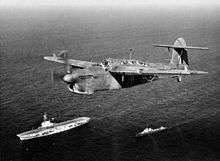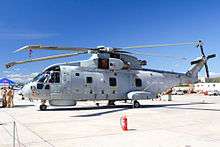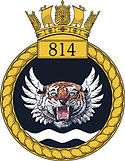814 Naval Air Squadron
| 814 Naval Air Squadron | |
|---|---|
|
814 NAS badge | |
| Active |
1938–1942 1944–1970 1973–2000 2001–Present |
| Country |
|
| Branch | Fleet Air Arm of the Royal Navy |
| Type | Ship-based squadron |
| Role | Anti-Submarine Warfare |
| Garrison/HQ | RNAS Culdrose |
| Motto(s) |
In hoc signo vinces (Latin: "In this sign you will conquer") |
| Equipment | Merlin HM.2 |
| Battle honours | Atlantic 1940 |
814 Naval Air Squadron is a squadron of the Royal Navy Fleet Air Arm. It was formed in December 1938 and has been disbanded and reformed several times. Its nickname is "the Flying Tigers", not to be confused with the American Volunteer squadron of WWII.
History

The squadron was formed on December 1938 as a Torpedo plane Squadron equipped with six Fairey Swordfish aircraft.[1] Originally embarked on HMS Ark Royal, it transferred to HMS Hermes at the outbreak of the Second World War. HMS Hermes helped search for the Graf Spee and taking part in the Battle of Dakar, damaging the French battleship Richelieu on 8 July 1940.[2] HMS Hermes travelled to the Indian Ocean December 1940, providing support for the land forces in British Somaliland and capturing 5 enemy merchant ships. In May 1941 the squadron provided support to the Royal Air Force in Iraq and later providing convoy protection in the Indian ocean. In April 1942, while the squadron was ashore, HMS Hermes was sunk by Japanese aircraft off Ceylon and 814 subsequently disbanded at Katukurunda in December.[2] The squadron was reformed in July 1944, equipped with Fairey Barracudas, to embark on HMS Venerable and headed to the Far East for patrols, although seeing no action.
In post-war years, the squadron was equipped with the Fairey Firefly, Grumman Avenger and Fairey Gannet aircraft for anti-submarine warfare onboard HMS Vengeance, receiving the Boyd Trophy for its high standard of operational efficiency in 1951.[1] In 1960 the Squadron was equipped with its first helicopter, the Westland Whirlwind HAS.7, later replaced with the Westland Wessex HAS.1. The Wessex HAS.3 was introduced in 1967, giving the squadron its first radar-equipped helicopter. During this time, the squadron was embarked on HMS Victorious and HMS Hermes to patrol east of the Suez. It was disbanded in July 1970.[1]
814 Squadron was reformed in March 1973 with four Westland Sea King HAS.1 helicopters at RNAS Prestwick (HMS Gannet) and embarked on tours of duty with HMS Bulwark and HMS Hermes, during which it assisted with the evacuation of Cyprus.[1] The Sea King HAS.2 was introduced in 1977, becoming the first Royal Navy Squadron to be fitted with passive sonar equipment. The squadron arrived at RNAS Culdrose on 9 April 1976. In August 1982 the squadron embarked on HMS Illustrious for South Atlantic patrols. It was upgraded to the Sea King HAS.6 on October 1990, embarking onboard HMS Invincible for the Gulf, Bosnia and Kosovo Wars. It was disbanded on December 2000.[1]
Reformed
It was reformed again in October 2001 equipped with the Merlin HM.1, designed to be deployed aboard ships or operate from shore. Training is performed by 824 NAS. It has seen operational service aboard HMS Illustrious, Operation Telic in Iraq and in the Persian Gulf area. In 2012 it was involved in Exercise Joint Warrior off the coast of Scotland again with HMS Illustrious.[3] 814 NAS alternates duties with 820 NAS.
During 2014 the Merlin HM.1 was replaced by the Merlin HM.2.
Aircraft operated

The squadron operated a variety of different aircraft and versions:[4]
- Fairey Swordfish I
- Fairey Barracuda II
- Fairey Firefly FR.1, FR.4, 5 & AS.6
- Grumman Avenger AS.4 & AS.5
- Fairey Gannet AS.4 & T.2
- Westland Whirlwind HAS.7
- Westland Wessex HAS.1 & HAS.3
- Westland Sea King HAS.1, HAS.2/2a, HAS.5 & HAS.6
- AgustaWestland Merlin HM.1 & HM.2
References
Citations
Bibliography
- Sturtivant, R; Ballance, T (1994). The Squadrons of The Fleet Air Arm. Tonbridge, Kent, UK: Air-Britain (Historians) Ltd. ISBN 0-85130-223-8.
External links
- Royal Navy – 814 Squadron
